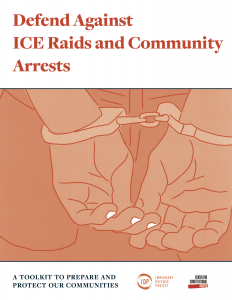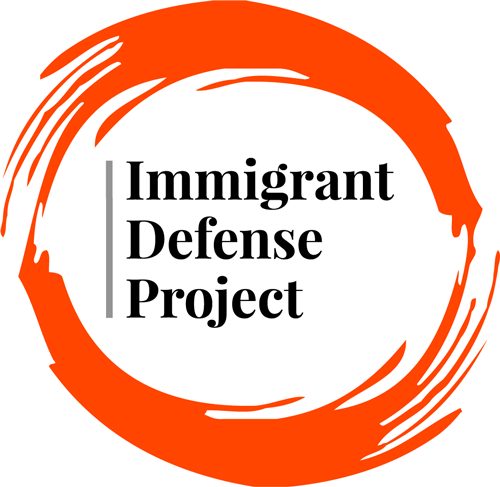
In early 2020, DHS targeted New Yorkers through aggressive ICE raids, only to be slowed down by a global pandemic. In February 2020, undercover ICE agents shot a bystander in the face in Brooklyn. DHS revealed that it was conducting a 24/7 surveillance operation in New York—Operation Palladium—and threatened to send Border Patrol tactical units (BORTAC) to New York to boost the presence of local ICE teams. In March 2020, as the coronavirus pandemic shut down schools and businesses across New York, ICE announced that it would continue conducting raids, focusing on “mission critical” targets. While ICE slowed down intensive policing tactics during the pandemic, ICE continued to detain and deport people, effectively facilitating the spread of the pandemic within the US and globally. As the Department of Homeland Security (of which ICE is part) has evolved, ICE has increasingly invoked “public safety” to justify mass detention and deportation. In doing so, the agency has relied on longstanding logics that fuel policing and mass incarceration, a key one being that some people represent a perpetual threat and therefore are deserving of extremely punitive measures. Below is an updated foreword from our ICE raids toolkit, “Defend Against ICE Raids and Community Arrests.” The toolkit challenges the criminalization of non-citizens and the hierarchy of “worthy” versus “unworthy” immigrants; it also works towards dismantling ICE and the Department of Homeland Security.
For social justice advocates everywhere, the four years of the Trump administration presented relentless and ongoing challenges. For example, Trump’s virulent anti-immigrant agenda, widespread human rights violations, and racist fearmongering, and his repeated invocation of the threat of immigrant criminality, have had a significant and lasting impact on the US political landscape. The Biden administration’s commitment to undo the harms of the Trump administration present a welcome shift, but in order to fully address the challenges we face, we need to take stock of the conditions that made Trump’s ethnonationalist agenda so powerful.
Trump, and now Biden, inherited the world’s largest exclusion and deportation policing apparatus—the Department of Homeland Security (DHS)—and a robust police-to-deportation pipeline. Both administrations also embrace the political justification for border policing and mass detention and deportation—the widely held consensus that the borders must be “secure” and that immigrants with criminal convictions are a worthy “national security” target.
DHS was founded in 2002, requiring a major restructuring of government agencies and priorities, along with a tremendous diversion of federal spending—“the largest, most important restructuring of the federal government since the end of World War II,” which created “the most militarized federal entity after the Pentagon.”
The logic that justifies this massive government diversion of resources to police, imprison and expel immigrants is based on a continuum of an ongoing cycle of expulsion, exclusion, and criminalization of those deemed “unworthy” of belonging. Since the founding of the country, representations of “dangerous outsiders” or “the enemy within” have been an integral part of nation-building and defining belonging in the United States. Immigration laws have historically played a key role in social control and in reinforcing white supremacy, capitalism, heteronormativity, and the threat of “criminal” others who might destabilize the social order. But it wasn’t until the 1980s when the deportation of non-citizens with criminal convictions surfaced as a stated focus of the federal government. The political climate of the subsequent years helped to realize this focus through various initiatives. These included the passage of harsh laws in 1996 that expanded the criminalization of immigrants and consequently, the government’s power to arrest, imprison and deport non-citizens on a massive scale.
The political focus on excluding, policing, and expelling immigrants got a huge boost with the founding of the DHS. At this time, DHS issued a strategic plan, Operation Endgame, to achieve “a 100% removal rate for all removable aliens,” a document which laid the groundwork for the current regime of ICE policing and raids. During the Obama administration, DHS increasingly focused rhetorically and materially on people with criminal convictions as a key threat to “public safety,” and the targeting of these people increasingly served as the justification for ICE’s mission. DHS under Obama successfully tapped into the logics and apparatus of decades of extensive criminalization targeting communities of color —including the vilification that drives racialized policing, discriminatory prosecution and sentencing, and mass imprisonment—which has significantly shaped the terms by which we continue to fight the deportation state today.
Since the founding of DHS, the U.S. has deported over 5 million people — almost twice as many people than in the previous 100 years combined. The effective merger of the “homeland security state” and the prison industrial complex over the past 18 years has led to the normalization of mass deportation, one which relies heavily on the criminalization of immigrants. As a result, DHS — its underlying logic, the profound human suffering it has caused, its relationship with other agencies, and the political interests it serves — has not until recently received the kind of public scrutiny an institution of such magnitude and influence deserves.
Not only have millions of lives been irreparably disrupted, these policies are at odds with the current forward-thinking movement to reduce the harms of over-policing and mass incarceration. The success of this cruel system depends, in part, on the dehumanization of whole social groups, including strategically deploying labels such as “criminal,” “illegal,” or “felon” to shape public attitudes. At the same time, the government has incorporated and exploited the harmful ideologies and tactics of the so-called “War on Crime” and “War on Drugs” to escalate the racialized policing, mass imprisonment, surveillance, and excessive punishment of immigrants and other socially marginalized groups. The lines between the criminal legal system and immigration system have become dangerously thin.
It is no accident that ICE guides and trains its officers to use techniques that further the reach and harms of policing of communities of color. Much like other law enforcement agencies with documented discriminatory outcomes, ICE policies and strategies encourage and justify overly-aggressive policing tactics, widespread surveillance, and a disregard for constitutional and human rights. ICE’s unchecked zeal to target, arrest, and deport immigrants with convictions not only destroys families and communities, but also reinforces the inequalities of the criminal legal system upon which many of its policies rest.
Yet despite the enormity of this system, it is not without its weaknesses. As calls to #AbolishICE have shed light on the harms of this system, we must continue to call for the disentangling of the criminal legal and immigrations systems, as well as for the dismantling of DHS and the institutionalization of the massive system of exclusion and expulsion. A system that creates so much human pain, erodes fundamental fairness and human rights, and threatens the safety of millions is unsustainable. As the oppression grows, so too will the number of people who organize to reject its dehumanization, curb its growth, and uphold dignity and justice. We must continue to revisit key lessons, adjust our approach, support the leadership of communities on the frontlines, and expand our toolbox accordingly.
